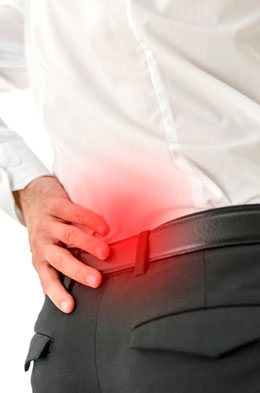Chronic lower back pain is a common problem faced by many across the globe. A delay in the treatment could cause severe problems. This article provides some information on the treatment options available for this condition.

The lower back, also known as the lumbar spine, is the last section of the spinal cord. It is made up of bones which are called vertebrae. Between each vertebra, there are discs made up of tissues that have an elastic texture, making the lower back strong and flexible. The vertebrae are connected to each other with the help of ligaments which provide strength and support to the spine. The pain occurs in the part of the spine which has the maximum movement. When a person stands upright, it is the lower back that provides support, and bears the weight of the whole body. Besides, the flexibility of the lumbar spine is the main reason due to which, we are able to perform various movements like bending, rotating, etc. The lower back also plays an important role in protecting some tissues of the nervous system, organs of the abdomen, and the pelvis.
The lower back, is mostly, considered to be at a higher risk of getting injured due to accidents, or while bending, thereby resulting in pain. It may also occur due to irritation in the nerves that connect the spine to the nervous system. Usually, pain is considered to be acute, in case of sudden onset of severe pain that resolves in a few days. However, when the pain continues for a long period of time then the person could be affected by the condition.
Diagnosis
Chronic lower back pain is a severe condition, and can cause major discomfort to an individual. Sometimes, the exact cause of the pain is not detectable. The patient's medical history may be checked, and some physical examination tests would be performed. If these are not enough, then pathological tests such as an X-ray examination, MRI, CT scan, blood tests, EMG, bone scans, etc., might be recommended.
Treatment
The treatment for this medical condition depends on its severity, and the underlying cause of the pain. It involves drug therapy, physical therapies, and also sessions on developing coping skills.
Physical Therapy: Many affected people tend to rest in bed for long, so as to avoid the severe pain associated with any sort of movement. But this is wrong, as sometimes resting may aggravate the pain in the lower back. The physical therapist teaches the patient some stretching exercises to strengthen one's lower back. Although one may have to perform these exercises for a long period of time, the results are quite effective. Physical therapy would depend on the age of the person, and the cause of the pain. Along with exercises, acupuncture also helps in reducing the pain. Massage therapy is another form of treatment which might prove beneficial.
Medications: The most common medicine that is prescribed for pain in the lumbar spine is a non-steroidal anti-inflammatory drug. If the pain is due to nerve irritation, then antidepressants and anti-seizure medications may also be prescribed. However, these drugs should not be taken without consulting a doctor, as they may have many side effects.
Coping Skills: As the person affected has to bear the pain for a long period of time, anxiety and depression may arise. For this reason, it is necessary that the patient must undergo therapy sessions with a psychologist, who would teach the patient some skills, to cope with the chronic pain.
In extremely severe medical conditions, surgery may have to be performed. However, these are quite rare and may involve risks, so even when recommended it is better to give it a second thought. Effective treatment might prove beneficial to the affected person, however, there have been cases where the pain springs back again. Besides following the aforementioned treatments, the occurrence of this medical condition can be prevented by following an exercise regimen or performing other activities such as running, swimming, and walking.
Disclaimer:
This Buzzle article is for informative purposes only, and should not be used as a replacement for expert medical advice.


 The lower back, also known as the lumbar spine, is the last section of the spinal cord. It is made up of bones which are called vertebrae. Between each vertebra, there are discs made up of tissues that have an elastic texture, making the lower back strong and flexible. The vertebrae are connected to each other with the help of ligaments which provide strength and support to the spine. The pain occurs in the part of the spine which has the maximum movement. When a person stands upright, it is the lower back that provides support, and bears the weight of the whole body. Besides, the flexibility of the lumbar spine is the main reason due to which, we are able to perform various movements like bending, rotating, etc. The lower back also plays an important role in protecting some tissues of the nervous system, organs of the abdomen, and the pelvis.
The lower back, also known as the lumbar spine, is the last section of the spinal cord. It is made up of bones which are called vertebrae. Between each vertebra, there are discs made up of tissues that have an elastic texture, making the lower back strong and flexible. The vertebrae are connected to each other with the help of ligaments which provide strength and support to the spine. The pain occurs in the part of the spine which has the maximum movement. When a person stands upright, it is the lower back that provides support, and bears the weight of the whole body. Besides, the flexibility of the lumbar spine is the main reason due to which, we are able to perform various movements like bending, rotating, etc. The lower back also plays an important role in protecting some tissues of the nervous system, organs of the abdomen, and the pelvis.